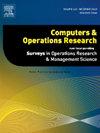利用异构无人机队优化任务分配和路由操作,以提供紧急医疗服务
IF 4.1
2区 工程技术
Q2 COMPUTER SCIENCE, INTERDISCIPLINARY APPLICATIONS
引用次数: 0
摘要
本文研究了利用异构无人机(UAV)优化任务分配和取送操作的问题。我们特别讨论了紧急医疗用品(包括药品、疫苗和基本医疗救助)的分发,以及生物血液样本的采集与分析。我们明确考虑到了独特的挑战,如供应短缺、时间窗口和地理因素。该问题首先被表述为一个混合整数线性规划模型,旨在最大化执行一系列紧急医疗保健取送任务所带来的总利润。针对大规模基准实例,提出了基于 Q-learning 的增强型自适应大邻域搜索(QALNS)。QALNS 在基准实例上表现出卓越的性能。与 Gurobi 求解器和最先进的自适应大型邻域搜索算法相比,QALNS 还能将求解质量平均提高 5.49% 和 6.86%。我们对影响 QALNS 算法性能的关键因素(如学习率和折扣指标)进行了敏感性分析。最后,我们就无人机队的使用和网络设计提供了管理见解。本文章由计算机程序翻译,如有差异,请以英文原文为准。
Optimizing task assignment and routing operations with a heterogeneous fleet of unmanned aerial vehicles for emergency healthcare services
This paper studies the optimization of task assignment and pickup and delivery operations using a heterogeneous fleet of unmanned aerial vehicles (UAVs). We specifically address the distribution of emergency medical supplies, including medications, vaccines, and essential medical aid, as well as the collection of biological blood samples for testing and analysis. Unique challenges, such as supply shortages, time windows, and geographical considerations, are explicitly taken into account. The problem is first formulated as a mixed-integer linear programming model aimed at maximizing the total profit derived from the execution of a set of emergency healthcare pickup and delivery tasks. An enhanced Q-learning-based adaptive large neighborhood search (QALNS) is proposed for large-scale benchmark instances. QALNS exhibits a superior performance on benchmark instances. It also improves the quality of the solutions on average by 5.49% and 6.86% compared to the Gurobi solver and a state-of-the-art adaptive large neighborhood search algorithm, respectively. Sensitivity analyses are performed on critical factors contributing to the performance of the QALNS algorithm, such as the learning rate and the discount indicator. Finally, we provide managerial insights on the use of the fleet of UAVs and the design of the network.
求助全文
通过发布文献求助,成功后即可免费获取论文全文。
去求助
来源期刊

Computers & Operations Research
工程技术-工程:工业
CiteScore
8.60
自引率
8.70%
发文量
292
审稿时长
8.5 months
期刊介绍:
Operations research and computers meet in a large number of scientific fields, many of which are of vital current concern to our troubled society. These include, among others, ecology, transportation, safety, reliability, urban planning, economics, inventory control, investment strategy and logistics (including reverse logistics). Computers & Operations Research provides an international forum for the application of computers and operations research techniques to problems in these and related fields.
 求助内容:
求助内容: 应助结果提醒方式:
应助结果提醒方式:


